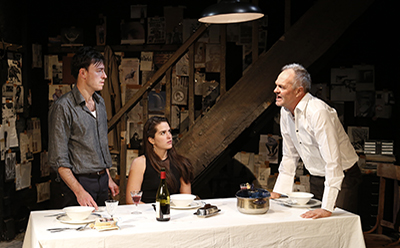 Has Scandinavian culture had any hotter time since that of the Vikings? A big part of this is due to a particular slant on crime fiction. From Stieg Larsson’s Millennium Trilogy of books demanding Hollywood film adaptations through huge sales, to episodes of The Bridge on SBS, the Scandic take on the genre is exciting readers and viewers everywhere. Seizing on this trend, La Mama has programmed a season of “Nordic Noir” to give audiences a more modern take on crime and suspense.
Has Scandinavian culture had any hotter time since that of the Vikings? A big part of this is due to a particular slant on crime fiction. From Stieg Larsson’s Millennium Trilogy of books demanding Hollywood film adaptations through huge sales, to episodes of The Bridge on SBS, the Scandic take on the genre is exciting readers and viewers everywhere. Seizing on this trend, La Mama has programmed a season of “Nordic Noir” to give audiences a more modern take on crime and suspense.
Nordic Noir differs from Miss Marple-like `Whodunnit’ through features such as a dark mood and characters of moral complexity. These are also evident in Courage to Kill by Lars Noren, judged as “Sweden’s greatest playwright” by The Swedish Book Review. At its core, the Australian premiere of Courage to Kill by company Public Front is a drama on the frictions within families. The production has some recognizable noir elements, including the outstanding promotional image by Lachlan McDougall and Sarah Walker.
Eric (Luke Mulquiney) is a waiter, just like his now-retired father Ernst (Stephen House) was. We begin in his messy apartment where he gulps down cigarette smoke. He almost vibrates with obsessive energy as he trims pictures and columns from magazines, manically circling words and sticking the pieces on his walls. These add to an ever-growing collage of images with faces contorted or obscured, or having features cut out.
Ernst is staying with Eric, and it’s not a happy cohabitation. Dad pushes his son’s buttons by making requests Eric doesn’t feel like accommodating. We very quickly get a sense of unresolved conflict between the pair, and of the bonds of family that force Eric to associate with Ernst. Explosive episodes recall family Christmases where people who don’t get along all year gather and find very quickly that Yuletide spirit isn’t enough to suppress old irritations.
Reasons for discord between father and son are slowly revealed. Tensions escalated with the arrival of Radka (Tamara Natt), Eric’s sometime girlfriend. Here we get to explore ideas of respect, boundaries, and stereotypical features of masculinity.
Interpreting a play is like skiing cross-country. A narrow trail where you can see everything ahead is boring. Yet, insufficient markings can leave you without any sense of a course or progress. I found Courage to Kill often didn’t give me enough clues on where we were. As a result, my attempts to rationalise why certain events were happening became a distraction.
The ambiguities began from the very beginning. Eric’s manic magazine trimming, rather than looking purposeful, seemed erratic at times as he trimmed part of the title off of a magazine column. In partly unbuttoned shirt and unzipped jacket, Ernst walked around the apartment complaining about the cold. “Are these characters mad?” I asked myself. In the first act, lighting and sound effects drew attention to themselves, distorting the sense of naturalism that had previously been established.
When Radka made an appearance in the second act to find Ernst alone in the dining room, she immediately took on a strange demeanour. First pressing herself against a wall in fear, then almost leering at him as if he presented some opportunity, she showed a cartoonish progression through emotions. Natt also seemed to do a lot of chin acting in the style of Michael Douglass, which used so much almost made me laugh.
My confusion accumulated as Radka, having delivered a speech on unwanted male attention, let Ernst touch her repeatedly despite delivering rebukes. House is no George Clooney or Sean Connery though, and doesn’t project any sort of charm to make Radka’s welcoming of his advances remotely credible.
I wonder if the translation by Marita Lindholm Gochman added a further oddity that weighed on the production. For example, when dancing with Radka, Ernst asked “Do you think I’ve lost my depth of soul?” – a line both clunky and bizarre to a woman he’s just met.
More credible is Mulquiney’s sometimes hyper-reactive Eric, venting towards the oppressive presence of his father by sniping to manage his stress. Unlike some of the other explosive episodes that seemed to plateau, the final scenes had genuine tension, and brought out the best in all players. I did find the relationship of the conclusion to the set collages quite tenuous though.
Is this Nordic because of Noir, or red herrings? Courage to Kill might be a good one for students of theatre to see, to make their own judgement on how well Richard Murphet’s direction works with the text. After a bit of a rough start on the review and opening night, some of what I found as distractions might not strike others as so, or may yet be smoothed out. It’s quite possible that House might find some more gears between sappy and belligerent, and that some of the extraneous movement between him, Natt and Mulquiney will evolve into a more instructive dance.
Director: Richard Murphet Featuring: Stephen House, Luke Mulquiney, Tamara Natt Sound Design: Adam Casey Lighting Design: Kris Chainey Set / Costume Design: Charlotte Lane Stage Management: Daniel Barca
Courage To Kill
La Mama Theatre, 205 Faraday Street, Carlton
Performance: Wednesday 6 July 2016
Season continues to 17 July 2016
Information and Bookings: www.lamama.com.au
Image: Luke Mulquiney, Tamara Natt and Stephen House in Courage To Kill – photo by Jeff Busby
Review: Jason Whyte
